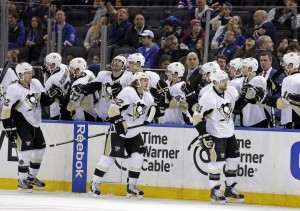The 2015-16 Pittsburgh Penguins are clearly a different team from just one year ago. In fact, they’re a much different team than just six months ago and a big part of their turnaround is one of the most criticized players in hockey, Phil Kessel.
We all know the reputation Kessel carried during his eight-year stint in Toronto. He’s a lazy, out-of-shape locker room killer that’s impossible to relate to or coach. Does that sound about right?
Oh yeah, there was also that hot dog story.
Unfortunately for those that tried to tear him down based on the above narrative, he’s been none of the above in his first season with the Penguins.
Kessel has had his struggles throughout the year. Overall, his goal totals have been disappointing and his inability to finish prime opportunities was frustrating to watch earlier in the season. Of course, a lot of other factors have impacted his production, such as Pittsburgh’s slow start that included the firing of a coach who stymied the team’s offensive potency.
Still, everyone wanted more. And, when they didn’t get immediate gratification, they classified the Kessel acquisition as a failure after a mere two-to-three months and wanted him gone.
I imagine that isn’t the case anymore.
Playoff Phil

Playing in Toronto for eight seasons meant very little playoff exposure for Kessel. However, when he did get the opportunity to play in the postseason, he flourished. Coming into this playoff season, he had averaged just under a point-per-game with 21 total points in 22 games-played.
Through five playoff games with the Penguins, he has three goals and six points, playing a crucial role in eliminating the New York Rangers.
His 1.2 points-per-game places him in a two-way tie for seventh among playoff scorers. Only Evgeni Malkin and Sidney Crosby have produced at a better clip for this team, boasting an impressive 1.75 and 1.60 respectively. That’s exactly the type of balance Jim Rutherford imagined when he acquired Kessel last summer.
Kessel has also turned up the dial in the intensity department, bringing a more physical game than what anyone has come to expect. He isn’t playing a grinder’s role by any means, but he is battling and winning 50/50 pucks. He’s also back checking.
Did you ever imagine a time that anyone would be giving him credit for his defensive play?
Outside of his even-strength play, Kessel has also been a big reason the Penguins currently sit atop the NHL in power play success rate with a whopping 38.1-percent. The Penguins have learned how to use him on the left dot and it isn’t the one-timer everyone has been hoping for.
It’s shooting for sticks.
When you have Crosby, who is nearly unmatched in his ability to deflect pucks in traffic, you capitalize on that skill. The Penguins are doing exactly that and Kessel’s accuracy is one of the reasons its successful. Among his three assists versus the Rangers in round one, two came with the man advantage. Both of them were primary assists.
But, What About That Cap Hit!
Kessel’s $6.8 million cap hit has weighed on the minds of many, mainly due to his production in the regular season. However, I pose the following question to those who feel he’s overpaid.
In a season that saw overall goal totals in the NHL drop to their lowest point since 2003-04, otherwise known as the dead puck era, was it fair to ask Kessel to score 40 or more?
The going rate for production in Kessel’s salary range was roughly 65-70 points. He finished the season with 59 but consider that his production under Mike Sullivan was .78 points-per-game. At that rate, he would have finished with 64 points through 82 games.
Also, if you overlook Sullivan’s first two weeks, which saw the Penguins go 2-5-0 while transitioning to a new head coach, his production jumps to .83 points-per-game and roughly 68 total points in an 82-game season. That total would have tied Patrice Bergeron for the eleventh highest total in the NHL among forwards.
Unless the league finds a way to increase scoring, it’s time to adjust expectations and the perception of what a scorer’s totals look like. Pittsburgh is getting a solid return-on-investment.
Paying Dividends
While it’s impossible to tell where Pittsburgh would be without the Kessel trade, it’s important to remember what they gave up for him while also understanding that he’s a much bigger asset to this team, as currently constructed, than a 19-year old that will need time to develop.
Kapanen fighting for 4th line duty in AHL playoffs. It's early, but wow–anybody want to undo Kessel deal? https://t.co/vvqacHbJei
— Dan Kingerski (@TheDanKingerski) April 25, 2016
Kapanen was the centerpiece in Toronto’s return. Of course, the Leafs also received Pittsburgh’s 2016 first-round draft pick. In the long run, Toronto could very well “win” this trade if both Kapanen and whoever they select this summer end up being NHL contributors. But again, the Penguins are capable of winning right now.
The same thing couldn’t be said prior to Kessel’s recent surge.
The tandem of Carl Hagelin and Kessel has been paramount to Pittsburgh’s success. And, I imagine that will continue for the foreseeable future with both of them locked up for at least the next three seasons. So, when Kessel has his slumps and scoring droughts, as all scorers do, remember what he means to this team in crunch time.
Try to remember that the Penguins, with all of the depth they’ve built over the past year, can sustain their winning ways due to a balanced lineup. Then, try to picture what this lineup would look like sans Kessel and think to yourself…
Would the Penguins be the contender they are right now without him? I’m fairly confident your answer will be ‘no’.